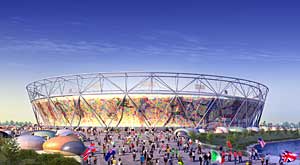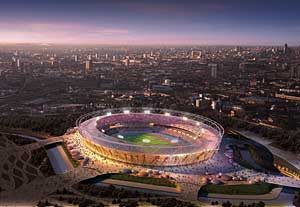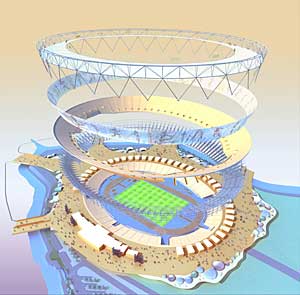The British architectural profession has had a largely negative response to plans for London’s 80,000-seat Olympic stadium, which were unveiled last month. Critics say that the design, by HOK Sport and architect Peter Cook of HOK, lacks the flair of conceptual images shown during London’s bid to host the 2012 Games. But the city’s Olympic Delivery Authority (ODA) defends the stadium as an adaptable and practical structure that can be re-used.



Critics have panned designs for the 2012 Olympic Stadium in London, an 80,000-seat arena created by HOK Sport and architect Peter Cook of HOK. The building is intended to be dismantled and re-assembled elsewhere after the Games.
Rod Sheard, an architect with HOK Sport, has described the stadium as “a very simple building with a very tight, compelling bowl.” The structure’s cable-supported roof has a diameter of 92 feet . A detachable top tier of 55,000 seats will be removed after the Games, leaving just the lower tier of 25,000 permanent seats. Most of the services for catering, toilets, and retail stalls will be located in removable pods on a 360° ground level concourse outside the bowl.
Critics of the stadium, including several newspaper columnists and architect Will Alsop, have voiced a long list of complaints starting with the fact that there was no competition to chose the designers. Many have likened the arena’s cable-supported roof and concrete bowl to a gassometer—an old type of gas storage facility. Worse still, some worry that the roof, which only covers 67 percent of the seats, could present a weather hazard. Detractors add that the no-frills building seems barely attributable to Peter Cook, a founder of the avant-garde 1960s group Archigram, and complain that the ODA was too focused on legacy rather than architectural pizzazz.
One feature that may add some excitement is a printed fabric curtain that will wrap around the stadium and feature electronic images of the 200 nations competing in the Olympics. The stadium’s supporters also point to its sustainable quality, in that it can be dismantled after the Games and moved from its site at the southern end of the Olympic Park in East London’s Lower Lea Valley to serve as a sports venue elsewhere.
Many observers worry that finding a buyer for the stadium might be difficult and that the ODA is unlikely to recoup its money. During the last two years, the project’s price tag has soared from the $574 million originally budgeted, to a projected $1 billion—and the cost of dismantling the arena would be extra.
When London originally bid for the 2012 Summer Olympics in late 2004, it used conceptual images of a stadium by Foreign Office Architects, whose roof design was inspired by the way muscles support the body. While this scheme boosted the identity of London bid’s, the ODA decided instead to pursue an economical, demountable solution for the stadium on a design-build basis.
Some critics have called for a competition to select a new building whose architecture is less tame yet remains sustainable. The success of such efforts, though, seems an unlikely prospect in an increasingly cost-sensitive climate. The construction firm Sir Robert McAlpine, which built Arsenal Football Club’s iconic Emirates Stadium at Highbury and Islington in north London, is due to begin work next April and finish b y the summer of 2011.

Post a comment to this article
Report Abusive Comment